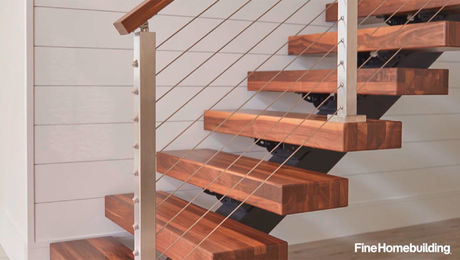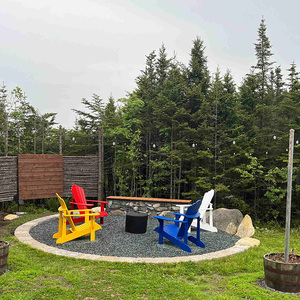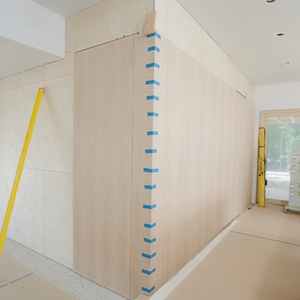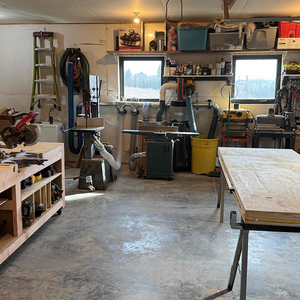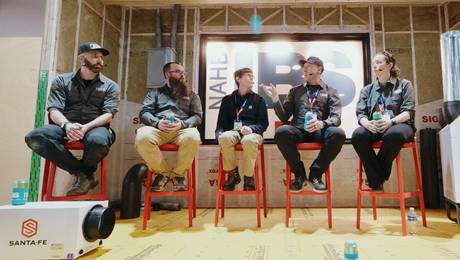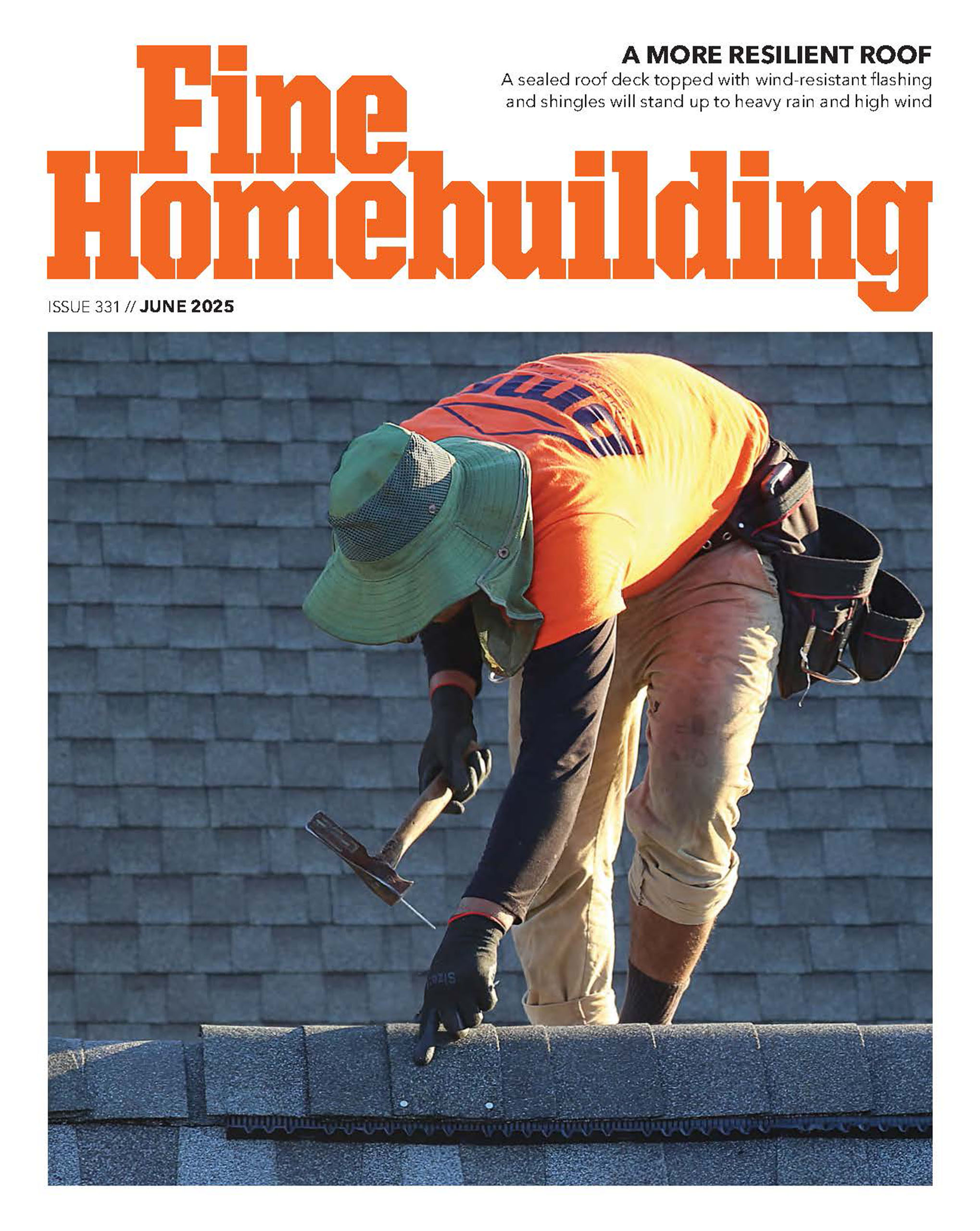Codes vary, but the need for safety is constant when installing fans
I’d like to clear up a couple of things written by Fernando Pagés Ruiz in his article “Choosing and Installing a Ceiling Fan” (FHB #142, pp. 98-103). I’m not sure if the state of Nebraska or the city of Lincoln has adopted the National Electrical Code, but most places use it as a standard. Article 422-18, “Support of ceiling suspended fans,” states that all boxes used to mount a fan that weighs 35 lb. or less (not 50 lb.) shall be permitted to be supported by outlet boxes identified for such use. The boxes that Mr. Ruiz was telling the readers to use are not suitable for handling the weight or the movement of a ceiling fan.
Also, any fan that weighs 35 lb. to 50 lb. must be supported independently of the outlet box. As for the picture showing him using a 3-in. pancake box, there is a box made for this application. It straddles right over the joist and allows room on each side for wires.
Finally, the article states that Mr. Ruiz is a homebuilder in Lincoln, Nebraska, but I didn’t read anywhere whether he is a licensed electrician
—Rob Sitzmann, Minneapolis, MN
Fernando Pagés Ruiz replies: I think it’s important to point out that the average 52-in. ceiling fan weighs 21.6 lb., including the light kit. Nevertheless, I commend Mr. Sitzmann for his knowledge of the National Electrical Code (NEC), and for his eyesight. His summary of the NEC requirements for supporting heavy and lightweight ceiling fans is absolutely correct. He is also correct to point out that the octagonal metal box shown being installed on p. 100 of my article does not conform to NEC requirements.
Although I should have been more conscious of Fine Homebuilding’s national audience when we took that picture, I promise we weren’t breaking any laws. Standard metal boxes have been used for many years in ceiling-fan installations without incident, and many localities, including Lincoln, Nebraska, where I work, continue to allow their use. When I called my local electrical inspector to double-check the code requirements, he told me, “Those UL-approved metal boxes are like swatting flies with a Howitzer. That’s why we don’t require them.”
Of course, the opinions of a building official from Lincoln won’t hold much weight in Peoria. In the article, I mentioned that the ceiling box must be rated for ceiling-fan use, but I should have been more explicit. Wherever the National Electrical Code regulations apply, the ceiling box (whether metal or plastic) must be clearly marked with these words: ACCEPTABLE FOR FAN SUPPORT.
As to my qualifications, I have been building homes for nearly 20 years in New York and Los Angeles, and in the Midwest. My electrician, who appears in the photographs featured in the article, is a state-licensed master electrician with about 30 years in the trade.
A simple fix for fan-blade wobble
Although fan blades are matched for mass, variations in the density of the wood can affect their center of mass. The first step in curing a wobbly fan should be to switch the positions of two adjacent fan blades. On occasion, this is all it takes to eliminate most of the wobble.
—Dave Dwyer, via e-mail
Consider the lowly bath mat
Like Larry Becksted (FHB #141, “Q&A,” p. 22), I inherited a house in which the builder installed glazed wall tiles on the shower-stall floor. Rather than rip up the existing floor, apply a traction product or build on a new layer of unglazed tile, I chose an inelegant, low-tech solution: a rubber bath mat. Such mats are probably a good idea even on 2-in. floor tile because water on hard surfaces is not trustworthy, even for the most agile among us.
—Nelson Sanger, via e-mail
No need to remove dry rot
In his letter to the editor, Don Waller states that the organisms that cause dry rot must be removed (FHB #142, p. 8). It is my understanding that the organisms that cause dry rot will stop attacking wood if the wood is dry. These organisms are present in all houses, in the walls and floors, and will not attack dry wood.
According to Timber Decay in Buildings: The Conservation Approach to Treatment (by Brian Redout, John Fidler, Ingral Maxwell, E & FN Spon, 1999), “The widely accepted principle that timber is not decayed by fungi if kept at a moisture content below 20% was devised by Cartwright and Findlay in 1946. This rule contained a safety margin, as the authors believed that the minimum moisture level required by wood decay fungi in most practical situations was probably 22-24%.”
If the rotted studs are dried before the wall is closed and the sources of moisture are removed, the new studs will not rot.
—Chris Chase, via e-mail
Rainwater collection doesn’t have to be expensive
As someone who has installed several rainwater-collection systems, including my own, I feel compelled to dispute Peter Pfeiffer’s seeming assertion that a system needs to have such a high price tag (FHB #142, pp. 84-89). There are hundreds of people in this area who are extremely happy with systems that cost a fraction of those Mr. Pfeiffer described. Furthermore, the fiberglass tanks that are generally sold for rainwater storage are coated with a UV-block and can also be painted. Even at that, many systems use polyvinyl tanks, which are much cheaper yet. Also, the recommendation that you need a ten-month supply of water stored is just ludicrous.
—Bill Goodwin, Austin, TX
A clarification about water purifiers
We read the article “Rainwater Collection Systems” with interest (FHB #142, pp. 84-89). As manufacturer of the Mighty Pure Ultraviolet Water Purifier that is pictured and mentioned in the article, we thought we should write to clear up a mistake.
The unit described and mentioned is an ultraviolet water purifier (not a filter) and is manufactured in stainless steel; therefore, it is intended for permanent installation and will offer many, many years of use. In order to keep the ultraviolet water purifier in fine operating condition, the quartz sleeve (inside the stainless chamber) needs to be thoroughly cleaned at least once per year (and more often, depending on individual installation and water parameters and conditions), and the germicidal lamp needs to be replaced every 10,000 hours of use (approximately every 14 months) at a cost of approximately $75.
—Ann M. Wysocki, Atlantic Ultraviolet Corp., Hauppauge, NY
More on rainwater collection
I would like to point out a few variations on rainwater collection (FHB #142, pp. 84-89) that may help your readers. Many people use cisterns in Australia because the bore (well) water is so full of minerals that it is fit only for sheep to drink.
The cistern shown was huge. A practical method for sizing a cistern is to look at the rain charts to see how long your area goes without rain, and size for that. Many homes in Australia use only 2000-gal. to 4000-gal. cisterns.
Also, it may be a lot cheaper to use a combination well and cistern—the cistern piped to drinking, dishwasher and shower, with the well to everything else. Here in Virginia (where I live part time), a well drilled 400 ft. costs $3,500, and pump and piping are another $1,500—a lot less than $30,000 for a huge cistern. With this system, you can have a much smaller cistern and still have ten months of storage. A huge cistern might make sense in Western Australia, where bores have to be 3000 ft. to hit water and where it rains only two or three months a year, followed by nine months of clear blue skies. (I guess that’s a bad thing if your cistern is too small; otherwise, it sounds really good to me.)
The local health department may be overly hostile to the idea of drinking rainwater. In Virginia, anything other than an encased well requires a variance from the main health office in Richmond, which the local health department says rarely approves anything. Other states may be more flexible in their approvals.
Used stainless tanks can be purchased (old dairy tanks, etc.) for around $1 a gallon—1500-gal. tanks for $1,500—just a little above the stated 75¢ a gallon for the concrete tanks and a lot quicker for installation. They can be buried in one day, like a septic tank. And water in stainless tanks won’t pick up alkali the way water sitting in concrete for months can. Or consider a premade concrete septic tank for water storage—usually cheaper than 75¢ a gallon.
And finally, the 4-in. PVC pipe to the cistern is not usually approved for use with drinking water. You may have to get special PVC that is drinking-water approved. Check local codes.
—Bill Stewart, via e-mail
Building a safer crosscut sled
Rex Alexander’s article about building a crosscut sled for his table saw (FHB #140, pp. 80-81) has a serious error that could result in many operators’ fingers being chopped off needlessly.
As shown in the photo on p. 80, it is natural for the operator to hold the sled with the operator’s thumbs on the backside of the plywood support. This positioning makes it far too easy for the thumbs to be placed where the blade inevitably comes through the support at the finish of each cut. That smarts!
A simple fix is to glue a short length of 4×4 to the backside of the support, which keeps the blade covered and your thumbs away. I’m surprised that you didn’t catch this omission.
—Robert R. McAusland, Seattle, WA
More cautions and tips for building modular retaining walls
I really enjoyed Andy Beasley’s article on modular retaining walls (FHB #141, pp. 78-83) and thought he did an excellent job of covering the basics. A word of warning, though, concerning his statement that “walls up to about 4 ft. … are considered gravity walls, meaning they need nothing more than the force of gravity to keep them in place.” Each wall block has its own specs on how high you can take it before you need a soils engineer to step in and help you. For instance, I have worked with blocks that need to be engineered once they are above 2 ft.
Besides height, the other big factor that determines the need for engineering is the load behind a wall. If Andy’s blocks were rated to 4 ft. without needing geogrid, that actually means that they are rated to that spec if the ground behind them does not slope up (creating more weight trying to push the wall base out) or if there is no parking lot, driveway, building or second retaining wall above the wall.
The good news is that most block manufacturers will do the soil engineering for you. You may need to send soil samples, but that’s easier than rebuilding a failed wall.
Concerning the base: Any time you tamp base material, be it for a retaining wall, brick patio or anything else, most walk-
behind tampers (the size that two guys can take on and off a truck) compact only 2 in. of base at a time. So if you want to compact 6 in. of base, build it up 2 in. at a time and compact it fully.
One of the neatest tricks for leveling the base for a wall is to dig the trench 4 in. to 5 in. wider than the tamper, and then install formboards as though you were pouring concrete. Use a transit to level the base, step up your formboards wherever your wall steps up, and then lightly backfill the formboards so that your tamper doesn’t knock them over. Then build up your base 2 in. at a time, and screed the top layer off of your formboards.
And Andy, thanks for the aluminum-shim idea. That one’s a winner!
—Steve Suter, Altoona, PA
It’s not bad to locate smoke alarms in the ceiling above the door
In Sarah Susanka’s recent “Drawing Board” column (FHB #142, pp. 38, 40, 42), we made a lame attempt at humor by labeling the locations of smoke detectors as “Good, bad and ugly” in the drawing on p. 38. We should have labeled them “Best, better and standard practice.” Sorry about that.
—The editors
ANSI standard has not been updated
In my article “Prescription Safety Glasses” (FHB #142, pp. 80-83), I not only missed the fact that Gump Worsley finally submitted to wearing a goalie mask during the last year of his hockey career, but I also sent all the manufacturers of safety glasses scrambling to find out if the government regulations had been changed without their knowledge. They haven’t. The standard that applies to safety glasses remains ANSI Z87.1 (not ANSI Z87.140 as was reported). I need a vacation.
—Tom O’Brien, associate editor
Volunteer for Habitat if you want to learn about building
Mike Guertin’s responses to Benjamin S. Barrall’s inquiry (FHB #142, “Q&A,” p. 24) about becoming a homebuilder are okay, but here is another idea: Sign up as a volunteer with Habitat for Humanity. Just about any city of size in the United States has a Habitat chapter or affiliate.
My work with Habitat for Humanity has given me enough confidence (as a 66-year-old retiree) to tackle the construction of a 3000-sq. ft. contemporary house in central Pennsylvania. Three cheers for Habitat!
—Roger J. Olson, via e-mail
Fine Homebuilding Recommended Products
Fine Homebuilding receives a commission for items purchased through links on this site, including Amazon Associates and other affiliate advertising programs.
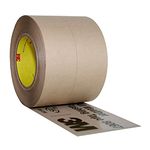
8067 All-Weather Flashing Tape

Reliable Crimp Connectors

Affordable IR Camera

